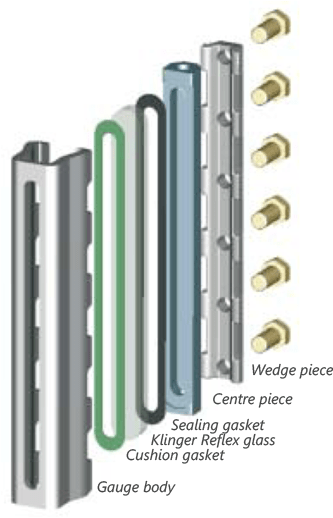The principle of the reflex glass is based on the difference in the refractive indices of liquid and gas or, in particular, of water and steam. The liquid column is contained within the recess of the centre-piece behind the gauge glass which is clamped within the gauge body.
If a ray of light encounters the surface of one of the 45 °C slanted grooves in the gas or steam space it is reflected to the opposite surface of the groove and from there totally reflected – back into the direction of observation. The steam or gas space therefore appears silverwhite.
The gauge glass – a KLINGER reflex glass – has prismatic right angled grooves on the side facing the water and steam spaces. Light rays entering from outside the gauge are either absorbed or reflected depending upon whether they enter the water or steam space.
The light ray which encounters the surface of a groove in the liquid space is almost totally absorbed. The liquid behind the reflex glass therefore appears black.



The advantage of the reflex gauge lies in its clear, unambiguous readability. This system makes false readings of the liquid level impossible and thereby eliminates dangers which could arise in this connection.
Applications
Indication
Very clear
Steam-Vapour space – silver white
Water-Liquid space – dark
Note: Only KLINGER original parts guarantee a trouble free operation of the gauge glasses. Therefore it is recommended to use only original spare parts for gauge glasses, mica shields, sealing gaskets and cushion gaskets.
